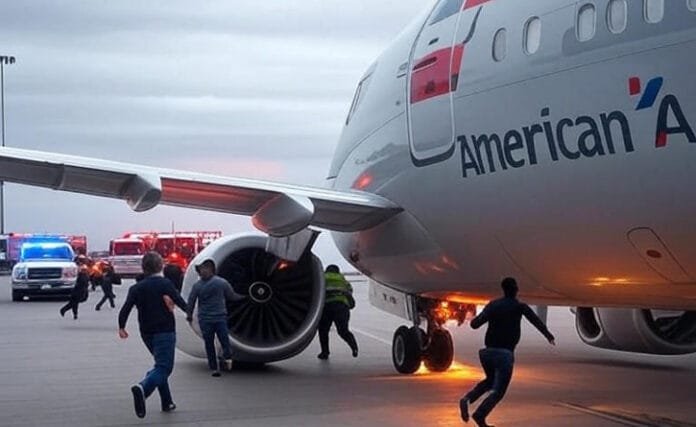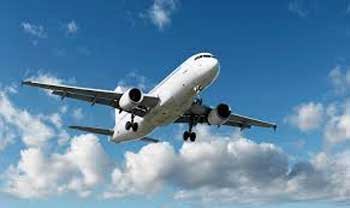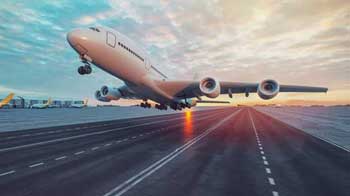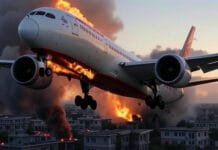A major aviation disaster was narrowly avoided at Denver International Airport on Saturday when the landing gear of an American Airlines Boeing 737 MAX 8 caught fire before takeoff. The aircraft, which was preparing to depart for Miami International Airport, had 179 individuals on board, including 173 passengers and 6 crew members. Thanks to quick emergency response and adherence to safety protocols, all individuals were safely evacuated, with only one reported minor injury. The Federal Aviation Administration (FAA) has launched a full-scale investigation into the incident.
Landing Gear Fire Sparks Emergency Response
According to initial reports, the aircraft was undergoing final checks on the runway when a maintenance issue related to a tire was noted. While initially considered non-critical, this oversight turned perilous as the landing gear ignited, causing smoke to envelop the aircraft. The fire was identified prior to takeoff, which enabled the crew to initiate emergency evacuation procedures without delay.
Eyewitnesses and passenger-recorded footage on social media reveal scenes of urgency as passengers slid down inflatable emergency chutes, quickly moving away from the smoke-filled plane. Emergency services responded swiftly, containing the situation and treating the injured individual onsite before transferring them to a local hospital.
173 Passengers and Crew Escape Catastrophe
Authorities confirmed that 173 passengers and six crew members were on the flight manifest. Following the fire, five individuals received onsite medical attention, while one person was transported to a hospital for minor injuries, likely sustained during the emergency slide evacuation.
Despite the alarming nature of the fire and the scale of the response, officials praised the efficiency of both the American Airlines crew and airport emergency teams for averting a disaster.
FAA Investigation Underway Into Possible Mechanical Failure
The Federal Aviation Administration (FAA) has initiated an in-depth investigation into the incident. The agency will examine whether the fire stemmed from a mechanical fault, such as a tire burst, or negligent maintenance procedures. A full technical review of the Boeing 737 MAX 8 aircraft, which has been removed from active service, is currently underway.
Officials have also confirmed that a section of the runway at Denver International Airport was temporarily closed following the incident, impacting other flight operations. Normal activity resumed shortly afterward.
Smoke Engulfs Plane as Passengers Evacuate
Social media videos recorded by passengers and bystanders showed thick smoke billowing from the undercarriage of the aircraft. The landing gear, visibly scorched, indicates the fire was both sudden and intense. These visuals further confirm the crew’s timely decision to evacuate, potentially saving lives.
Passengers were seen evacuating in an orderly fashion despite the chaos. Emergency slides were deployed, and firefighting units arrived within moments to suppress the fire and ensure no secondary ignition occurred.
American Airlines Issues Statement, Reviews Maintenance Logs
In its official statement, American Airlines acknowledged the fire and confirmed that the aircraft had reported a maintenance-related tire issue before the scheduled departure. The airline noted that the problem was initially assessed as minor but emphasized that safety remains the top priority, prompting a full internal investigation in coordination with the FAA.
“We are cooperating fully with federal authorities and conducting our own review to determine the root cause of this incident,” said an American Airlines spokesperson. “We are grateful to our crew and emergency responders whose swift action ensured the safety of everyone on board.”
Boeing 737 MAX 8 Under Renewed Scrutiny
This latest incident involving the Boeing 737 MAX 8, a model already under global scrutiny due to past safety concerns, is likely to reignite conversations about the aircraft’s reliability and inspection protocols. Although the fire did not occur mid-air, the fact that it originated while the aircraft was still on the ground suggests a possible oversight in pre-flight inspection or routine maintenance.
Boeing has yet to issue an official comment, but industry analysts expect that the manufacturer will cooperate closely with investigators, especially given the aircraft’s controversial history and the importance of restoring public trust.
Denver International Airport Operations Temporarily Disrupted
Following the emergency evacuation, one of the runways at Denver Airport was briefly closed. Multiple departing and arriving flights experienced delays, but operations resumed once the affected aircraft was removed and the scene was deemed secure.
Airport officials commended the coordinated efforts of firefighters, airport security, medical teams, and ground staff, noting that the emergency protocols functioned effectively under high-pressure circumstances.
Emergency Evacuation Protocols Prove Effective
Aviation safety experts have credited this incident as a textbook example of how well-practiced emergency procedures can save lives. The evacuation was executed within minutes, with all passengers accounted for and no serious injuries reported.
The successful evacuation further strengthens the case for routine emergency drills and crew preparedness, which are often overlooked in public discussions but are critical for aviation safety.
Passenger Accounts: ‘Smoke Was Everywhere’
Several passengers recounted their experience to local media and via social media posts. One traveler stated, “We heard a strange sound under the plane, and then smoke started rising. The crew told us to evacuate immediately. We didn’t wait—just slid down and ran.”
Others described the anxiety and confusion but commended the crew’s calm demeanor. “They stayed professional the whole time and helped people get off quickly,” said another passenger.
Aircraft Grounded for Inspection, Future Flights Unaffected
The American Airlines Boeing 737 MAX 8 involved in the fire has been permanently removed from service until a full inspection is complete. The airline assured passengers that no other flights were canceled as a direct result of the incident and that its fleet-wide safety checks are ongoing.
No other aircraft have reported similar issues in the hours following the Denver event, and air travel continues as scheduled nationwide.
Looking Ahead: FAA and Airline Investigations Will Determine Cause
As the FAA begins its inquiry, aviation analysts anticipate a detailed report within the coming weeks. Preliminary speculation centers around mechanical stress on the landing gear, possibly exacerbated by temperature, tire condition, or flawed maintenance checks.
The findings will determine whether further fleet-wide inspections of Boeing 737 MAX 8 aircraft are warranted and whether new safety guidelines or procedural revisions will be implemented across the industry.
Key Takeaways: Incident Highlights Importance of Rapid Response
173 passengers and 6 crew safely evacuated
Landing gear fire occurred pre-takeoff at Denver International Airport
Emergency slides deployed, one minor injury reported
FAA and American Airlines investigations ongoing
Runway temporarily closed, some flight delays experienced
Aircraft removed from service for full technical analysis
This incident, though alarming, underscores the critical importance of safety protocols, vigilant maintenance, and rapid response in preventing aviation tragedies. With the FAA and American Airlines now in full investigative mode, more details will emerge, shedding light on the technical lapses or unforeseen failures that led to this narrowly averted disaster.
















